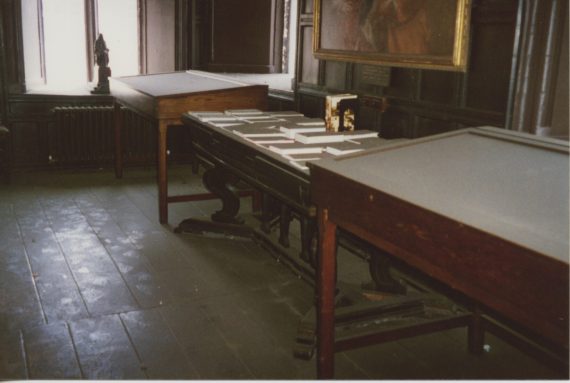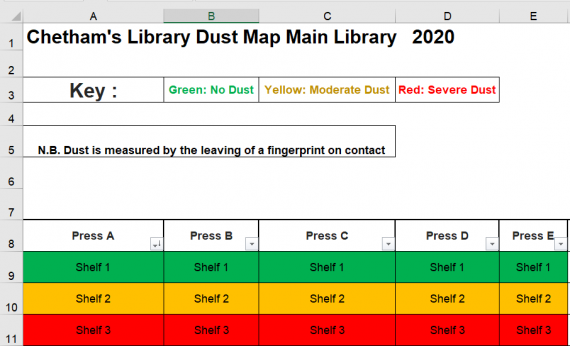- About
- Visiting
- What’s On
- Venue hire
- Catalogues
- Collections
- 101 Treasures of Chetham’s
- Digital Resources
- The Flowers of Histories
- A Book of Hours from France
- The Manchester Scrapbook
- Thomas Barritt of Manchester
- Art Treasures Examiner of 1857
- Manchester Association for Constitutional Order
- The North Western Museum of Science and Industry: Some Reminiscences by Richard Hills
- Criminal Manchester
- The Cup of Destiny
- Athenaeum Souvenir
- Middle English Manuscripts
- Manchester and Liverpool of Today
- Hollingworth’s Mancuniensis
- Memoir of Cecil Wray
- William Seward’s Diary
- The Anti-Monopolist
- Fishwick’s History of Rochdale
- Knyvett’s Defence of this Realm
- Tractatus de Nigromantia
- Axon Ballads
- Printed Books & Ephemera
- Archives & Manuscripts
- Prints and Photographs
- Blog
- Support us
Another One Bites The Dust

Next in our Conservation series, we will be exploring the damage caused to books and collections by dust. Dust may be something you would expect to find in old libraries, historic houses, and museums. But in fact, conservation staff battle on an almost daily basis to keep this agent of deterioration under control. Dust levels in collections must be managed because it causes damage in two ways. For example, the presence of the actual dust itself causes deterioration, whilst the abrasive removal from books can be potentially damaging, not to mention costly and time-consuming for staff.
Dust in historic libraries comes from a few different sources including the books themselves. As books are made from organic materials, they become more delicate as they age, leading to a breakdown of materials which contribute to dust fall. Another cause of dust surprisingly comes from the clothing fibres and skin cells of visitors and staff. Books on lower shelves will gather dust, which is disturbed on the floor, whilst those on upper shelves will attract dust from the ceiling and rising fibres, pollution, spores and dirt from open windows.

Above: an example of how quickly outside factors can contribute to dust fall. (Don’t worry it was taken care of immediately)
The presence of dust may just seem like an unfortunate cosmetic problem, however, over time it can cause cumulative damage which results in a process called cementation. This is when the dust attaches itself permanently to a surface and causes visible damage to an object. How quickly this takes place depends on the conditions collections are kept in. Humidity (water levels in the air) plays a crucial role in this. Dust cementation occurs at a faster rate if humidity is high.
The removal of dust from books if carried out incorrectly can cause as much damage as the dust itself. Therefore, it is essential that the correct conservation method is carried out. Dependent on book size it is best to carry out the clean in pairs. Dust must be gently swept off the top and sides of the text block using a soft brush, such as a pony hair brush; a face mask must be worn and the dust should be caught in a museum vacuum cleaner. Netting should be placed over the vacuum as a safety precaution and a low setting should always be used. To avoid abrasion gently brush dust away from the spine to the edge of the text block (fore-edge). Delicate books should not undergo this process, surprisingly 20th-century paper made from wood pulp is more susceptible to damage than paper before the 19th-century, as the wood pulp is more acidic leading to a breakdown of materials.
There are certain measures that can be put in place to help minimise dust fall in a library, however, some of these can be very costly or in some cases unpleasing to the eye. One of the simpler methods is to place an archival grade polyester sheet over the top of the books called melinex. The slightly static charge in melinex attracts dust to its surface rather than the top of the books. However, this is only effective if the books on the shelf are the same size, also it is very unsightly when placed on shelves in the visitor’s eye-line.
A more effective and visually pleasing option is that of silk taffeta coverings. Specific silk needs to be used for this process, due to factors such as moldability, shape memory and colour. Strips of this silk are heat cut to the exact length and width of the top of the books and then moulded until they sit flush. This would also minimise the need for as frequent manual book cleaning as the taffeta would be cleaned instead, resulting in less mechanical damage from handling. To protect individual volumes archival grade boxes (phase-boxes) can be used but this is impractical as a means of mass protection.

Above: an example of silk taffeta in place
Both the melinex and taffeta methods can be expensive and not always feasible for smaller or charity run organisations. But there are some more purse-friendly solutions to managing dust. For example, dust mapping is one of the easiest ways to minimise dust in the collection as you can track where it is most prevalent and make adjustments accordingly.
To track dust, you can use dust monitors, these are essentially cards with a sticky tape which are placed in different locations. Before these are put in place the date is recorded on them and after a few weeks, these will indicate how quickly the dust accumulates in different areas of the library. Another method of dust mapping can include a chart where a traffic light system indicates the levels of dust throughout a space. A colour-coded layout of the library is created indicating dust severity in the format of red, yellow, and green. Green being minimal red being heavy dust.

Above: an example of a dust mapping chart
We pride ourselves on our strong collections care here at Chetham’s and your generous support is helping us to fund conservation work like this throughout this pandemic while our visitor tour income is reduced. Thank you to every single person who has donated to our Covid-19 Appeal so far.
Blog Post By: Laura Bryer

2 Comments
an
Thankyou Laura, I learned something new , so eye-opening !
TJ Turner
Hello Chethams Library,
Thank you for the above info, very interesting.
However, I had got here by internet search-engine looking for info more specifically on how the chemicals evaporating from books (& I gather more from 20th century books onwards) can exacerbate asthma (& perhaps even possibly cause it), and perhaps also info on dust mites becoming airborne from books, if that is indeed the case.
Thank you again & I’m glad that donors kept you open throughout Covid lockdowns.
Regards,
TJ Turner